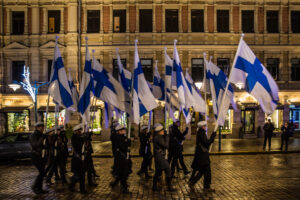On the 4th of July we celebrate our Independence Day. Nearly every country has a day that they celebrate their country’s formation or independence. Here is a list of the Nordic national days, three of which fall in June!
Denmark
In Denmark, Constitution Day (Danish: Grundlovsdag) is observed on June 5th. Both the first constitution establishing Denmark as a constitutional monarchy was signed on June 5th of 1849 and the current constitution of 1953 were signed on this date of their respective years.

The day is widely celebrated throughout Denmark with church congregations, associations and political organizations meeting for what is essentially “secular services.” These services include the raising of the Flag, a short presentation by a local politician or celebrity, and collective singing. Celebrations usually end with coffee and the eating of traditional buns and we can get behind any celebration that ends with eating. June 5th is also Father’s Day in Denmark.
Finland
Finland’s Independence Day (Finnish: Itsenäisyyspäivä) is on December 6th to celebrate Finland’s declaration of independence from Russia in 1917. It’s 100th anniversary was celebrated during 2017. Every year it is a national public holiday, and a flag day.
During the early decades Independence Day was a solemn occasion with patriotic speeches and special church services. From the 1970s onwards, however, Independence Day celebrations have taken livelier forms, with shops decorating their windows in the blue and white of the Finnish flag, and bakeries producing cakes with blue and white icing.

Iceland

Icelandic National Day is on June 17th (Icelandic: Þjóðhátíðardagurinn, the day of the nation’s celebration). It is an annual holiday in Iceland commemorating the foundation of The Republic of Iceland on June 17, 1944. This date also marks the end of Iceland’s centuries old ties with Denmark. The date was chosen to coincide with the birthday of Jón Sigurðsson, a major figure of Icelandic culture and the leader of the 19th century Icelandic independence movement.
Today, Icelanders celebrate this holiday on a national scale including a parade through each urban area with a brass band leading the way. Riders on Icelandic horses often precede the brass band and flag bearers from the Icelandic scouts follow the brass band. After the parade speeches are held out in the open, including one from Fjallkonan (the woman of the mountain), clad in Skautbúningur, who recites a poem. She represents the fierce spirit of the Icelandic nation and of Icelandic nature. In many ways this recalls the period of romanticism that reigned when the first steps toward independence were taken.
 Norway
Norway
Norwegian Constitution Day, (Norwegian: Syttende mai), is the national day of Norway and is an official public holiday observed on May 17th each year. The Constitution Day is celebrated in most small settlements and larger towns across Norway, with many variations.
From 1870, the day became more established with the first children’s parade in Christiania (now Oslo), an initiative taken by the author Bjørnstjerne Bjørnson, who also wrote the national anthem “Ja, vi elsker dette landet”. All over Norway, children’s parades form the central element of the celebrations, with school marching bands and an abundance of flags.
The longest parade is in Oslo where about 100,000 people participate in the main festivities in the city center. The parade includes some 100 schools and passes the Royal Palace where the royal family greet everybody from the balcony. The parade is broadcast on national television.
Sweden
Swedes celebrate their National Day of Sweden (Swedish: Sveriges nationaldag) on June 6th in honor of two historical events: Gustav Vasa being elected king (June 6 1523) and the adoption of a new constitution (June 6 1809). This day offers a rare chance to see Swedes waving the flag.
The original idea came from Artur Hazelius, who founded the Skansen open-air museum in Stockholm and held a national day celebration there on June 6 as early as the 1890s. In 1916, June 6 became the Swedish Flag Day, celebrating the fact that Sweden had acquired its own flag following the dissolution of the union with Norway in 1905.

Shop flags here!
